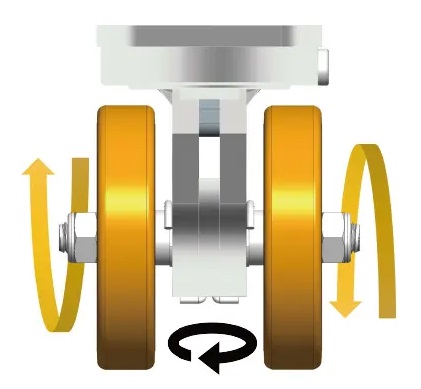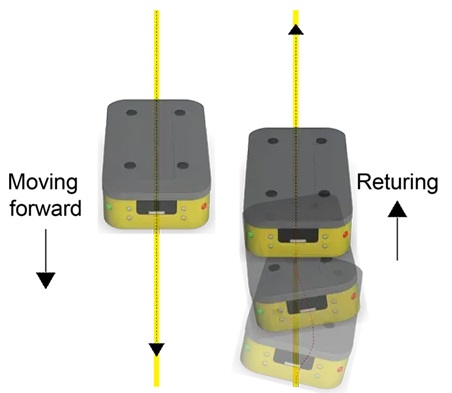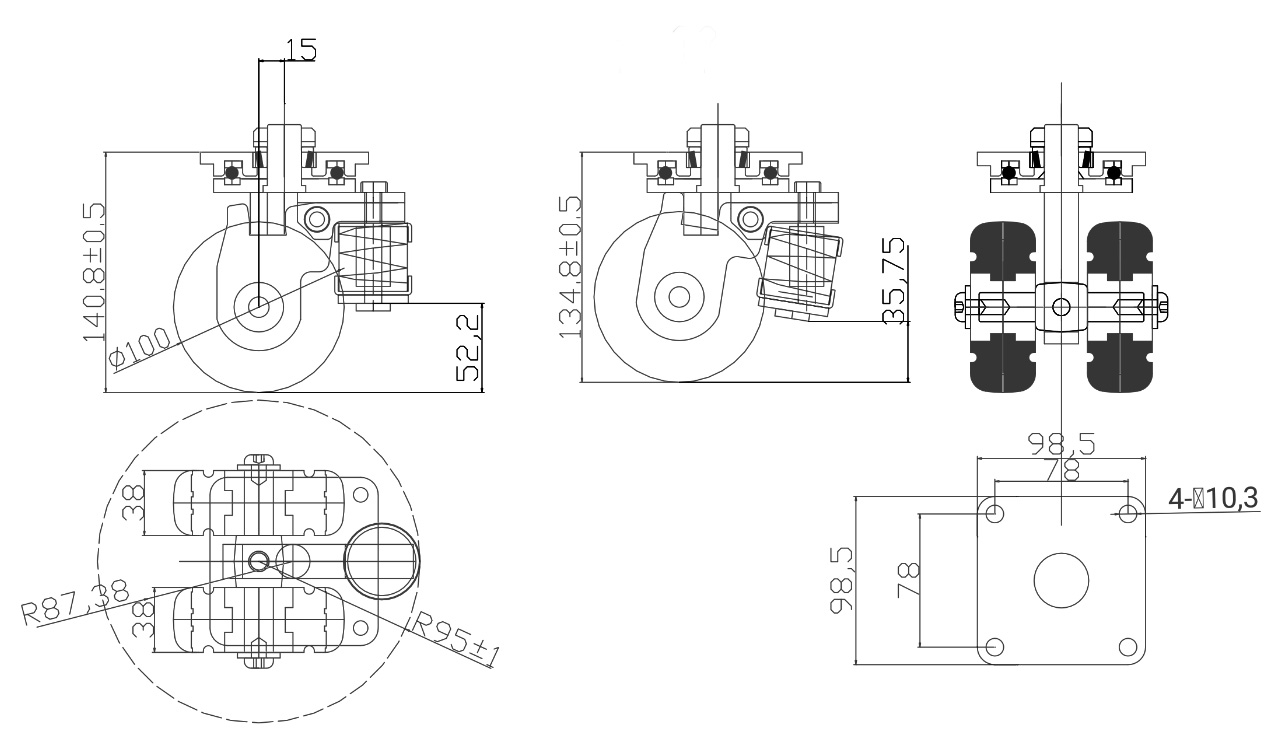Why we need Tilting agv casters
Tilting AGV casters, also known as tilting or articulated casters, are specialized components designed to enhance the performance and operational efficiency of AGVs. Their inclusion in AGV systems is driven by several significant reasons, each contributing to the overarching goals of improving stability, maneuverability, load distribution, and overall effectiveness of these automated systems. Here, we delve into an expansive discussion on why tilting AGV casters are essential, covering various aspects in detail.

Enhanced Stability
One of the primary reasons for utilizing tilting casters in AGVs is the enhanced stability they provide. Traditional rigid casters can struggle with maintaining balance, especially when the AGV operates on uneven surfaces or encounters obstacles. Tilting casters adjust dynamically to the surface contours, ensuring that all wheels maintain optimal contact with the ground. This continuous adjustment minimizes the risk of tipping over, which is crucial for maintaining the safety of both the AGV and its payload.
Dynamic Load Balancing
Tilting casters automatically compensate for changes in terrain and load distribution. On uneven surfaces, they pivot and tilt to distribute weight more evenly across all contact points. This dynamic load balancing is particularly beneficial in environments with frequent surface variations such as warehouses with different flooring materials or outdoor settings.
Reduced Risk of Tipping
The ability to tilt allows these casters to adjust the AGV’s center of gravity in response to changes in load and movement. This adjustment is vital during sharp turns or sudden stops, where the risk of tipping is highest. By maintaining a lower and more stable center of gravity, tilting casters significantly reduce the likelihood of accidents caused by tipping.
Improved Maneuverability
AGVs often operate in complex environments that require precise navigation and maneuvering. Tilting casters contribute significantly to improving the maneuverability of AGVs, making them capable of navigating tight spaces and performing intricate movements with ease.
Enhanced Steering Precision
Self-balance agv casters allow for more agile and responsive steering. When an AGV needs to make a sharp turn or navigate around obstacles, the casters pivot accordingly, reducing the turning radius and allowing for smoother directional changes. This agility is essential in environments like factories or warehouses where space is limited and efficient navigation is critical.
Adaptability to Varied Terrains
Different operational environments pose varied challenges in terms of terrain. Whether it’s navigating ramps, slopes, or transitioning between different floor types, tilting casters offer the adaptability needed to handle these conditions effectively. They ensure that the AGV maintains traction and stability, regardless of the surface it operates on.
Optimal Load Distribution
Load distribution is a critical factor in the performance and longevity of AGVs. Tilting casters play a pivotal role in ensuring that loads are distributed evenly, which helps in maintaining the structural integrity of the AGV and preventing premature wear and tear.
Even Weight Distribution
By continuously adjusting to the load and surface conditions, tilting casters distribute weight evenly across all wheels. This even distribution reduces the stress on individual casters and the AGV’s chassis, enhancing durability and reliability. It also ensures that the payload is transported smoothly without undue strain on any single point.


Protection of Delicate Loads
For AGVs transporting delicate or sensitive goods, maintaining a stable and balanced load is crucial. Tilting casters provide the necessary support to keep such loads secure, minimizing vibrations and jolts that could potentially damage the cargo. This is particularly important in industries like pharmaceuticals or electronics, where product integrity is paramount.
Vibration and Shock Absorption
In industrial environments, AGVs often encounter vibrations and shocks due to surface irregularities or sudden movements. Tilting casters are designed to absorb and mitigate these impacts, ensuring a smoother and safer operation.
Reduced Mechanical Stress
By absorbing shocks and vibrations, tilting casters reduce the mechanical stress on the AGV’s components. This not only extends the lifespan of the AGV but also minimizes the maintenance requirements, leading to reduced downtime and operational costs.
Enhanced Cargo Safety
Shock absorption is vital for protecting the AGV’s payload, especially when transporting fragile items. Tilting casters dampen the impact of bumps and jolts, ensuring that the cargo remains intact and secure throughout the journey.
Increased Operational Efficiency
The incorporation of tilting casters in AGVs leads to a significant boost in operational efficiency. From improved speed and agility to reduced downtime and maintenance, these casters contribute to a more effective and reliable automation system.
Faster Navigation
With enhanced maneuverability and stability, AGVs equipped with tilting casters can navigate their routes more quickly and efficiently. This increased speed translates to higher throughput and productivity, especially in high-demand environments like manufacturing plants or distribution centers.


Minimized Maintenance
The improved load distribution and shock absorption characteristics of tilting casters result in less wear and tear on the AGV. This means fewer maintenance interventions and longer intervals between servicing, ultimately leading to lower maintenance costs and increased uptime.
Noise Reduction
In many operational settings, noise reduction is a key consideration. Tilting casters contribute to quieter AGV operation by smoothing out the ride and reducing the clatter associated with rigid caster wheels.
Quieter Operations
The ability of tilting casters to adapt to surface variations and absorb shocks results in a quieter operation. This is particularly beneficial in environments where noise levels need to be kept to a minimum, such as hospitals, offices, or residential areas.
Improved Workplace Environment
Reduced noise not only enhances the comfort of workers but also contributes to a safer and more pleasant workplace environment. Lower noise levels can lead to better communication, reduced stress, and increased overall productivity.
Adaptation to Diverse Applications
Tilting casters make AGVs more versatile and adaptable to a wide range of applications. Whether used in manufacturing, logistics, healthcare, or retail, these casters enhance the AGV’s capability to perform effectively in diverse scenarios.
Versatility Across Industries
The adaptability of tilting casters makes them suitable for various industries. In manufacturing, they help navigate complex machinery layouts; in logistics, they ensure smooth transitions between different areas of a warehouse; in healthcare, they provide safe and quiet transport of medical supplies and equipment.
Customization Potential
Tilting casters can be customized to meet specific operational requirements. For instance, they can be designed to handle different weight capacities, terrain types, or environmental conditions. This customization enhances the AGV’s ability to meet the unique demands of different applications.
Future-Proofing AGV Systems
As technology advances and operational demands evolve, the need for more sophisticated and capable AGV systems grows. self-balance agv casters represent a forward-thinking approach to AGV design, ensuring that these vehicles remain relevant and effective in future applications.
Scalability and Upgradability
Tilting casters allow for scalability and upgradability of AGV systems. As businesses expand or change their operational setups, AGVs with tilting casters can be easily adapted to new requirements, providing a cost-effective solution for long-term use.
Integration with Advanced Technologies
The functionality of tilting casters can be further enhanced through integration with advanced technologies such as sensors and control systems. These integrations enable real-time adjustments and optimizations, further improving the AGV’s performance and reliability.
Tilting AGV casters are indispensable components that significantly enhance the performance, safety, and efficiency of automated guided vehicles. Their ability to improve stability, maneuverability, load distribution, and shock absorption makes them a critical element in modern AGV systems. By incorporating tilting casters, businesses can ensure smoother operations, better protection of goods, reduced maintenance costs, and a more versatile and future-proof automation solution. As industries continue to embrace automation and seek advanced solutions, tilting casters will undoubtedly play a pivotal role in shaping the future of AGV technology.



 English
English Spanish
Spanish German
German Russian
Russian Arabic
Arabic Portuguese
Portuguese Italian
Italian French
French Hebrew
Hebrew Turkish
Turkish